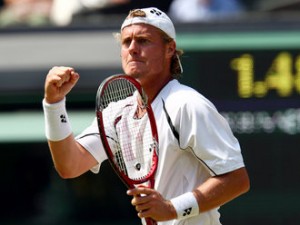The Hewitt Dilemma, and Why Grass May Solve It

After a strong showing at the 2009 Wimbledon, Lleyton Hewitt will look to repeat his success in 2010.
A good player, or even a great player, can’t avoid facing the game’s best players in the early rounds if he doesn’t improve his ranking.
But how can he improve his ranking if he keeps running into the game’s best players in the early rounds? I call it the Hewitt dilemma.
For Lleyton Hewitt, a winner of both Wimbledon and US Open titles, and the guy who spent all of 2002 at No. 1, the recent majors have been an exercise in frustration. Since 2006 he’s not only been through hip surgery, causing him to miss the 2008 US Open, but he has also faced Rafael Nadal four times at Roland Garros, none of which took place after the round of 16.
Since 2008, he’s also faced Roger Federer at the 2008 Wimbledon, the 2009 US Open, and the 2010 Australian Open. He lost no sets in lead-up to those matches with Federer, but the only set he won against The Great Swiss came in last year’s USO. He surprised more than a few when he took a set from Rafael Nadal in the 2006 RG, but won none from the Spaniard in their subsequent Parisian meetings.
The game has come a long way since the 2001-02 period, when Pete Sampras, Andre Agassi and Patrick Rafter’s careers were winding down, Marat Safin’s was stagnant and those of Federer, Andy Roddick, and Juan Carlos Ferrero had yet to bloom.
(Nadal, at the time, was 15 going on 16.)
Hewitt’s greatest skill was never the sheer velocity behind his serve or his forehand, but rather his speed, his consistency and his accuracy. Much to the dismay of Sampras, Rafter and Tim Henman, that accuracy translated into remarkably effective passing shots. Baseliners like Roddick, Agassi and even Federer had a different dilemma, as Hewitt had a knack for extending points long enough to either force errors or suddenly switch to offense.
In 2002, those skills were good enough to make him No. 1 for more than a year. In 2003, though, Ferrero, Federer and Roddick raised their games, and the littler Australian struggled to maintain the consistency that made him so tough. By the time he regained it in late 2004, Federer had firmly established himself as the game’s best.
Past the mid-point of this decade, the hard work the Australian has had to put in on the court resulted in struggles to stay in top shape. After his surgery in 2008, it’s been a rebuilding process for Hewitt, who for the first three slams of 2009 wasn’t even seeded. Even now that he has a number beside his place in the Grand Slam brackets, his reward has been third-round encounters with either Nadal or Federer for three majors in a row.
The way he got his seeding back, though, may point the way to an improved ranking in the future: grass. This week the former No. 1 is playing in the Gerry Weber Open, and with much of the tour’s big names in Queens, Hewitt is, after Federer, by far the most accomplished grass court player in the field.
A good result there would help, as would another favorable draw at Wimbledon. Last year, after all, he raised his ranking through a run to the quarters at the All-England Club.
At the time it was hard to see how a second-round assignment with Juan Martin del Potro was a “favorable” draw, even though the Argentine’s US Open breakthrough was still a couple of months away. With his big serve and remarkable power, del Potro looked a safe bet to overwhelm the Australian who stands seven inches shorter than he.
That assessment, though, overestimated how well del Potro could translate his power to grass, and underestimated Hewitt’s feel for the surface. Australia, after all, has a lot more grass courts than Argentina.
The lawns of Wimbledon remain a specialty, even if they don’t reward big serves and bold net rushing as much as they did in the ‘90s. Hewitt was, after all, tapped by Sampras himself as a future Wimbledon champion back in 2000 when he defeated The Pistol at Queens. Why? Because, Sampras said, Hewitt knew how to move on the grass.
That’s why the physically unimposing Hewitt has won Wimbledon and frequently been to the second week, whereas Safin, owner of both a big serve and great return has made just one trip to the semis: Safin, following his early loss in 2004, ranted that he could not move on the lawns and threatened never to come back.
Great movement, by itself, is not enough, though: Michael Chang made one appearance in the quarters in 1994 and received a merciless beating from The Pistol. Nikolay Davydenko owns both swift feet and a remarkably clean swing, but has made just one trip to the fourth round.
What separates Hewitt from those players is his familiarity with the surface, and his comfort on it. Familiarity with movement on the surface allowed him to keep the much bigger del Potro on the defensive for much of the encounter, resulting in a 6-3, 7-5, 7-5 victory.
It remains to be seen if something similar will happen this year. Hewitt was expected to draw Nadal last year, after all, before the Spaniard withdrew due to his knee injury. Should he face the Spaniard or the Swiss again in the early goings, a victory is probably more than can be reasonably expected.
But should he catch someone else – just about anyone but fellow lawn lover Roddick – his grass expertise may make the difference. A second week appearance in London may translate into a higher seeding in the future, with more second-week appearances in majors to come.











